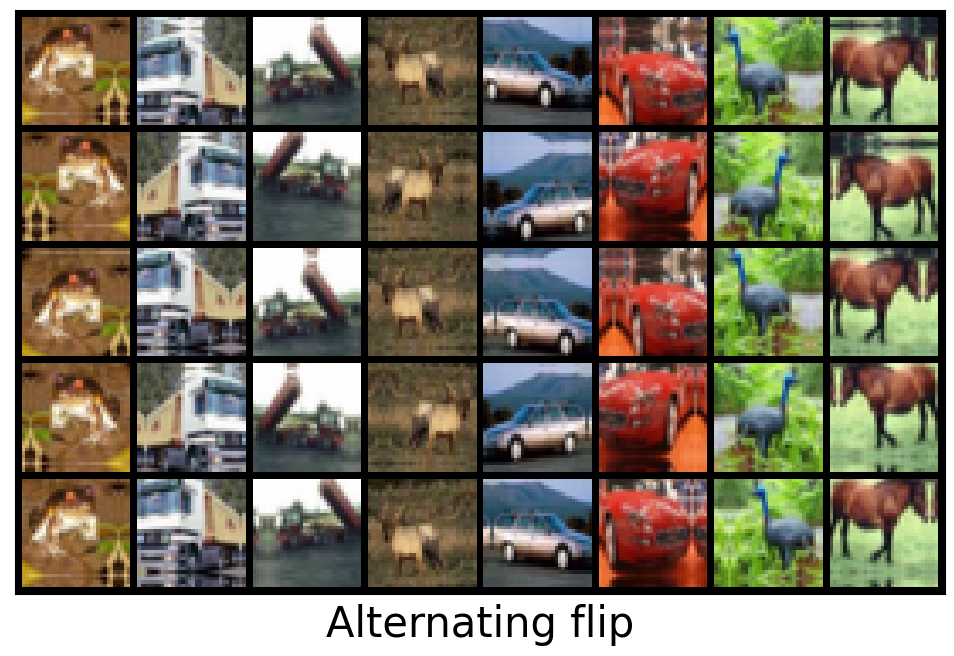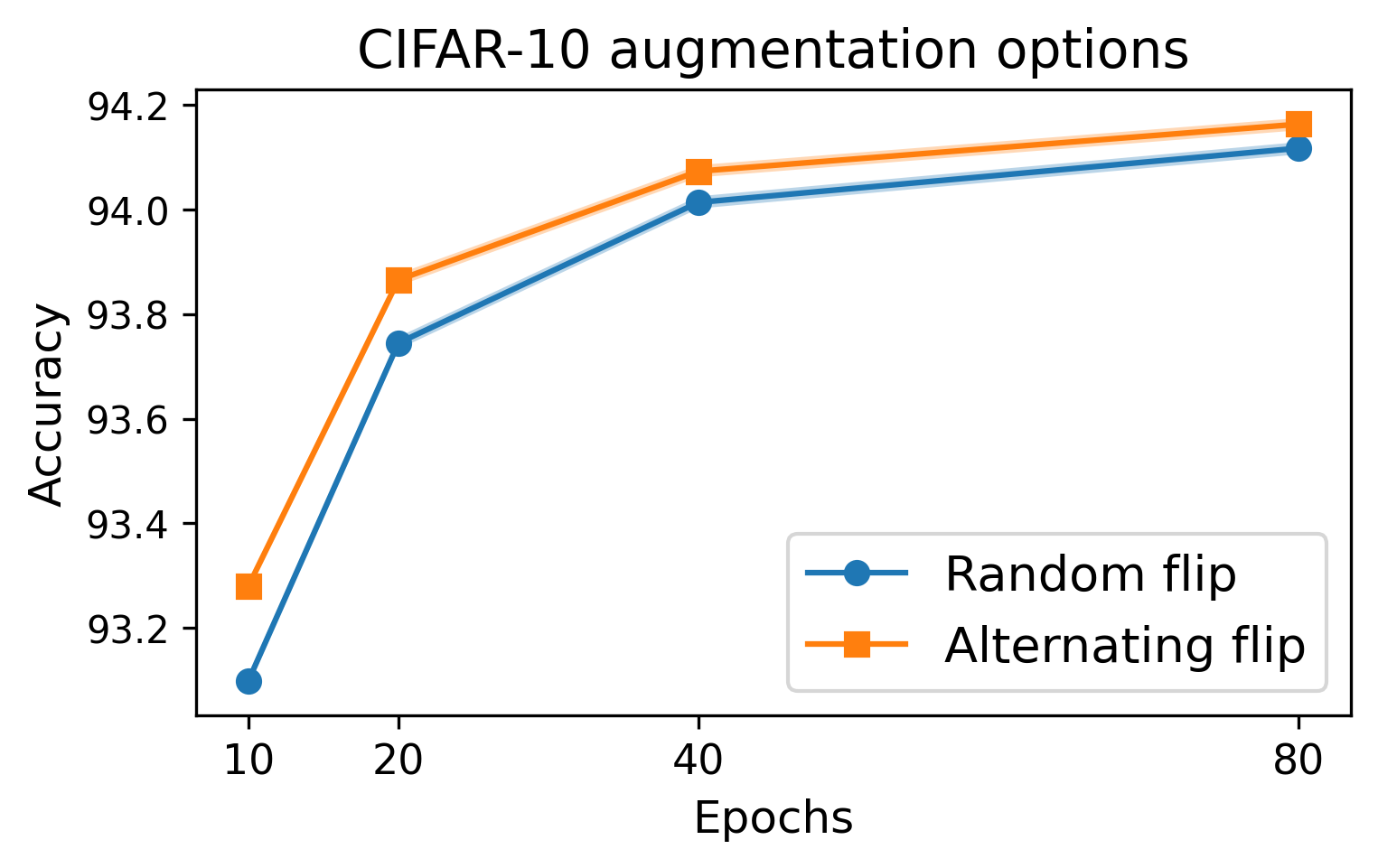This project contains state-of-the-art fast training methods for CIFAR-10:
| Script | Mean accuracy | Time | PFLOPs |
|---|---|---|---|
airbench94_compiled.py |
94.01% | 3.29s | 0.36 |
airbench94.py |
94.01% | 3.83s | 0.36 |
airbench95.py |
95.01% | 10.4s | 1.4 |
airbench96.py |
96.03% | 34.7s | 4.9 |
airbench96_faster.py |
96.03% | 27.3s | 3.1 |
For a comparison, the standard training used in most studies on CIFAR-10 is much slower:
| Baseline | Mean accuracy | Time | PFLOPs |
|---|---|---|---|
| Standard ResNet-18 training | 96% | 7min | 32.3 |
All timings are on a single NVIDIA A100 GPU.
Note: airbench96 has been improved since the paper from 46s to 35s. In addition, airbench96_faster is an improved (but more complicated) method which uses data filtering by a small proxy model.
The set of methods used to obtain these training speeds are described in the paper.
To train a neural network with 94% accuracy, run either
git clone https://github.com/KellerJordan/cifar10-airbench.git
cd airbench && python airbench94.py
or
pip install airbench
python -c "import airbench; airbench.warmup94(); airbench.train94()"
Note: airbench94_compiled.py and airbench94.py are equivalent (i.e., yield the same distribution of trained networks), and differ only in that the first uses torch.compile to improve GPU utilization. The former is intended for experiments where many networks are trained at once in order to amortize the one-time compilation cost.
CIFAR-10 is one of the most widely used datasets in machine learning, facilitating thousands of research projects per year. It is typically used for research which aims to understand fundamental properties of deep learning, rather than push the large-scale state-of-the-art. This repo provides fast and stable training baselines for CIFAR-10 in order to help accelerate this research. The trainings are provided as easily runnable dependency-free PyTorch scripts, and can replace classic baselines like training ResNet-20 or ResNet-18.
For writing custom CIFAR-10 experiments or trainings, you may find it useful to use the GPU-accelerated dataloader independently.
import airbench
train_loader = airbench.CifarLoader('/tmp/cifar10', train=True, aug=dict(flip=True, translate=4, cutout=16), batch_size=500)
test_loader = airbench.CifarLoader('/tmp/cifar10', train=False, batch_size=1000)
for epoch in range(200):
for inputs, labels in train_loader:
# outputs = model(inputs)
# loss = F.cross_entropy(outputs, labels)
...
If you wish to modify the data in the loader, it can be done like so:
import airbench
train_loader = airbench.CifarLoader('/tmp/cifar10', train=True, aug=dict(flip=True, translate=4, cutout=16), batch_size=500)
mask = (train_loader.labels < 6) # (this is just an example, the mask can be anything)
train_loader.images = train_loader.images[mask]
train_loader.labels = train_loader.labels[mask]
print(len(train_loader)) # The loader now contains 30,000 images and has batch size 500, so this prints 60.
Airbench can be used as a platform for experiments in data selection and active learning. The following is an example experiment which demonstrates the classic result that low-confidence examples provide more training signal than random examples. It runs in <20 seconds on an A100.
import torch
from airbench import train94, infer, evaluate, CifarLoader
net = train94(label_smoothing=0) # train this network without label smoothing to get a better confidence signal
loader = CifarLoader('cifar10', train=True, batch_size=1000)
logits = infer(net, loader)
conf = logits.log_softmax(1).amax(1) # confidence
train_loader = CifarLoader('cifar10', train=True, batch_size=1024, aug=dict(flip=True, translate=2))
mask = (torch.rand(len(train_loader.labels)) < 0.6)
print('Training on %d images selected randomly' % mask.sum())
train_loader.images = train_loader.images[mask]
train_loader.labels = train_loader.labels[mask]
train94(train_loader, epochs=16) # yields around 93% accuracy
train_loader = CifarLoader('cifar10', train=True, batch_size=1024, aug=dict(flip=True, translate=2))
mask = (conf < conf.float().quantile(0.6))
print('Training on %d images selected based on minimum confidence' % mask.sum())
train_loader.images = train_loader.images[mask]
train_loader.labels = train_loader.labels[mask]
train94(train_loader, epochs=16) # yields around 94% accuracy => low-confidence sampling is better than random.
This project builds on the excellent previous record https://github.com/tysam-code/hlb-CIFAR10 (6.3 A100-seconds to 94%).
Which itself builds on the amazing series https://myrtle.ai/learn/how-to-train-your-resnet/ (26 V100-seconds to 94%, which is >=8 A100-seconds)

